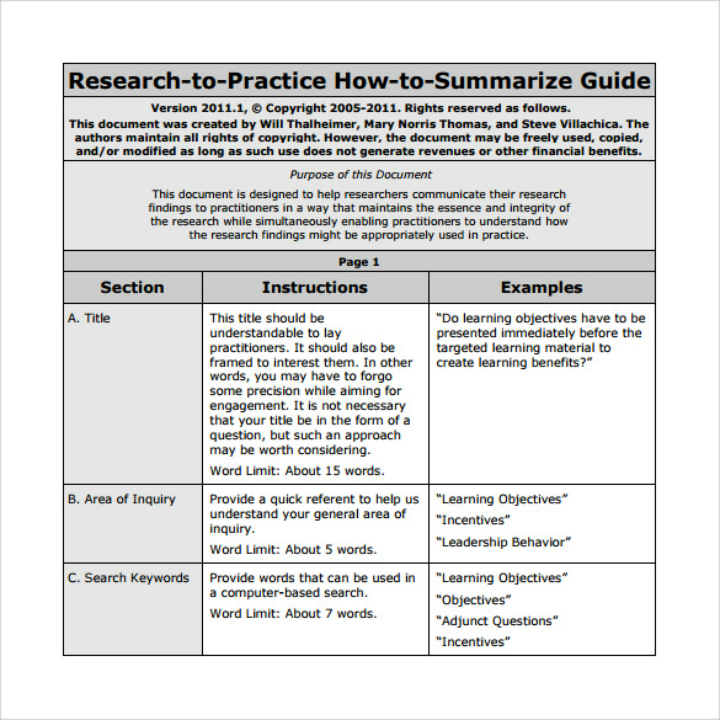
· Organize the literature review around key topics of concepts. Use headings or topic sentences to convey your organizational principle. Tell a story about the research. This will assist you with your organization e. References: This section is very useful for tracking down articles the authors refer to, that are relevant to your own work. Summarizing the articles When I write a literature review, I find it helpful to summarize each article for myself in the same way, in one document, so that I can then work with my summaries, rather than the articles A literature review is a document or section of a document that collects key sources on a topic and discusses those sources in conversation with each other (also called synthesis). The lit review is an important genre in many disciplines, not just literature (i.e., the study of works of literature such as novels and plays). When we say “literature review” or refer to “the literature,” we are talking about
Literature Review Summarising Easily | How To Summarize
This page is brought to you by the OWL at Purdue University. When printing this page, you must include the entire legal notice. All rights reserved. This material may not be published, reproduced, broadcast, rewritten, or redistributed without permission. Use of this site constitutes acceptance of our terms and conditions of fair use. A literature review is a document or section of a document that collects key sources on a topic and discusses those sources in conversation with each other also called synthesis.
The lit review is an important genre in many disciplines, not just literature i. There are a number of different situations where you might write a literature review, each with slightly different expectations; different disciplines, how to summarize a research articles for literature review, too, have field-specific expectations for what a literature review is and does.
A literature review can be a part of a research paper or scholarly article, usually falling after the introduction and before the research methods sections. In these cases, the lit review just needs to cover scholarship that is important to the issue you are writing about; sometimes it will also cover key sources that informed your research methodology. Lit reviews can also be standalone pieces, either as assignments in a class or as publications. This can be especially helpful for students or scholars getting into a new research area, or for directing an entire community of scholars toward questions that have not yet been answered.
Most lit reviews use a basic introduction-body-conclusion structure; if your lit review is part of a larger paper, the introduction and conclusion pieces may be just a few sentences while you focus most of your attention on the body.
If your lit review is a standalone piece, the introduction and conclusion take up more space and give you a place to discuss your goals, research methods, and conclusions separately from where you discuss the literature itself.
Lit reviews can take many different organizational patterns depending on what you are trying to accomplish with the review. Here are some examples:. Any lit review is only how to summarize a research articles for literature review good as the research it discusses; make sure your sources are well-chosen and your research is thorough.
More info on the research process is available in our "Conducting Research" resources. Usually you will how to summarize a research articles for literature review to synthesize research rather than just summarizing it. This means drawing connections between sources to create a picture of the scholarly conversation on a topic over time, how to summarize a research articles for literature review.
Often, the literature review is where you can establish your research as filling a particular gap or as relevant in a particular way. You have some chance to do this in your introduction in an article, but the literature review section gives a more extended opportunity to establish the conversation in the way you would like your readers to see it.
You can choose the intellectual lineage you would like to be part of and whose definitions matter most to your thinking mostly humanities-specific, but this goes for sciences as well. In addressing these points, you argue for your place in the conversation, which tends to make the lit review more compelling than a simple reporting of other sources.
Find Info For Find Info For Academics Admissions Current Students Athletics About Careers Prospective Students Research and Partnerships Quick Links Apply News President Shop Visit Give Emergency. Purdue Online Writing Lab College of Liberal Arts.
Writing Lab Purdue OWL Research Contact Site Map. Research and Citation Conducting Research. Welcome to the Purdue OWL This page is brought to you by the OWL at Purdue University. Writing a Literature Review A literature review is a document or section of a document that collects key sources on a topic and discusses those sources in conversation with each other also called how to summarize a research articles for literature review. Where, when, and why would I write a lit review?
What are the parts of a lit review? Conclusion: Summarize the key findings you have taken from the literature and emphasize their significance Connect it back to your primary research question How should I organize my lit review?
Here are some examples: Chronological : The simplest approach is to trace the development of the topic over time, which helps familiarize the audience with the topic for instance if you are introducing something that is not commonly known in your field.
If you choose this strategy, be careful to avoid simply listing and summarizing sources in order. Try to analyze the patterns, turning points, and key debates that have shaped the direction of the field. Thematic : If you have found some recurring central themes that you will continue working with throughout your piece, you can organize your literature review into subsections that address different aspects of the topic. For example, if you are reviewing literature about women and religion, key themes can include the role of women in churches and the religious attitude towards women.
Methodological : If you draw your sources from different disciplines or fields that use a variety of research methods, you can compare the results and conclusions that emerge from different approaches. For example: Qualitative versus quantitative research Empirical versus theoretical scholarship Divide the research by sociological, historical, or cultural sources Theoretical : In many humanities articles, the literature review is the foundation for the theoretical framework.
You can use it to discuss various theories, models, and definitions of key concepts. You can argue for the relevance of a specific theoretical approach or combine various theorical concepts to create a framework for your research. What are some strategies or tips I can use while writing my lit review? Writing teachers often say synthesis is like hosting a dinner party: imagine all your sources are together in a room, discussing your topic.
What are they saying to each other? Look at the in-text citations in each paragraph. Are you citing just one source for each paragraph? This usually indicates summary only. When you have multiple sources cited in a paragraph, you are more likely to be synthesizing them not always, but often Read more about synthesis here, how to summarize a research articles for literature review.
How to Summarize Articles for Your Literature Review: 5 Tips to Avoid Plagiarism
, time: 10:07The Literature Review | A Complete Step-by-Step Guide

How to summarize the articles you find into a coherent review Researching a literature review can find enough references from to fill a whole essay with quote after quote. Having gathered this information, it is difficult to filter out the essential information, from what is peripheral and what is largely irrelevant (see Fink, for further information) · The introduction should clearly establish the focus and purpose of the literature review. Dissertation literature review If you are writing the literature review as part of your dissertation or thesis, reiterate your central problem or research question and give a brief summary of the scholarly context. You can emphasize the timeliness of the topic (“many recent studies have focused on the problem of x”) or highlight a gap in the literature (“while there has been much research · Introduction – this is an important part of any research summary which provides necessary context (the literature review) that helps introduce readers into the subject (by presenting the current state of investigation, an important concept or definition, etc.)

No comments:
Post a Comment